Photographs: Reuters.
From a college dropout to heading an over $350 billion Apple empire, Steve Jobs dramatically transformed the worlds of personal computing, music and mobile phones, ushering in a new digital era.
Jobs, who died on Wednesday at the age of 56 after a seven-year battle with pancreatic cancer, was also the man behind the stupendous success of the computer animation firm Pixar, makers of Toy Story and Finding Nemo.
Though he himself never designed a computer in his life, it was because of him that the Apple products, while largely providing the same services as those from other companies, are perceived to be different.
...
The incredible success story of Steve Jobs
Image: Steve Jobs.Photographs: Lucas Jackson/Reuters
Born on February 24, 1955 to Joanne Carole Schieble and Abdulfattah Jandali, Steven Paul Jobs was adopted by Paul and Clara Jobs. Jandali was a graduate student from Syria who later became a political science professor.
Paul Jobs, who worked in finance and real estate before moving back to his original trade as machinist, moved his family down the San Francisco Peninsula to Mountain View and then to Los Altos in the 1960s.
From an early age, Steve Jobs was interested in electronics. As an eighth grader, after discovering that a crucial part was missing from a frequency counter he was assembling, he telephoned William Hewlett, the co-founder of Hewlett-Packard.
...
The incredible success story of Steve Jobs
Image: Steve Jobs stands under a photo of him and Apple-co founder Steve Wozniak, January 27, 2010.Photographs: Reuters.
Hewlett spoke with the boy for 20 minutes, prepared a bag of parts for him to pick up and offered him a job as a summer intern, according to The New York Times.
Jobs met Stephan Wozniak, with whom he co-founded Apple in 1976, while attending Homestead High School in neighbouring Cupertino.
After enrolling at Reed College in 1972, Jobs left after one semester, but remained in Portland for another 18 months auditing classes. In a commencement address given at Stanford in 2005, Jobs said he had decided to leave college because it was consuming all of his parents' savings.
...
The incredible success story of Steve Jobs
Image: Steve Jobs uses an iPad to run Apple TV at Apple's music-themed September event in San Francisco.Photographs: Robert Galbraith/Reuters.
Jobs returned to Silicon Valley in 1974 and took a job as a technician at Atari, the video game manufacturer. But, he left after several months and travelled to India with a college friend, Daniel Kottke, who would later become an early Apple employee.
Jobs returned to Atari and along with Wozniak, then working as an engineer at HP, began attending meetings of the Homebrew Computer Club, a hobbyist group that met at the Stanford Linear Accelerator Center in Menlo Park, California in 1975.
...
The incredible success story of Steve Jobs
Image: Beck Diefenback/Reuters.Personal computing had been pioneered at research laboratories close to Stanford and was spreading. Wozniak designed the original Apple I computer simply to show it off to his friends at the Homebrew.
It was Jobs who had the inspiration that it could be a commercial product. In early 1976, he and Wozniak, using their own money, began Apple in the Jobs family garage in Los Altos with an initial investment of $1,300 before securing the backing of former Intel executive A C Markkula, who lent them $250,000.
Wozniak would be the technical half and Jobs the marketing half of the original Apple I Computer.
...
The incredible success story of Steve Jobs
Image: Steve Jobs (centre) and musician Jack Johnson (right) at Apple's 'Let's Rock' event.Photographs: Robert Galbraith/Reuters.
Shortly thereafter, they moved the company to a small office in Cupertino. Reacting to Jobs' demise, a Twitter user named Matt Galligan wrote: "R.I.P. Steve Jobs. You touched an ugly world of technology and made it beautiful."
In April 1977, Jobs and Wozniak introduced Apple II at the West Coast Computer Faire in San Francisco, creating a sensation. The company went public in 1981, when its sales touched $600 million from $2 million in 1977.
By 1983, Apple was in the Fortune 500, an achievement for a new firm. In 1981, Jobs joined a small group of Apple engineers pursuing a separate project, a lower-cost system code-named Macintosh, which was introduced in January 1984.
...
The incredible success story of Steve Jobs
Image: Steve Jobs holds Apple's new Macbook Air notebook computer.Photographs: Robert Galbraith/Reuters.
Jobs recruited John Sculley as Apple's chief executive in 1983. Sculley, a former Pepsi-Cola chief executive, helped Jobs introduce a number of new computer models, including an advanced version of the Apple II and later the Lisa and Macintosh desktop computers.
But, the two men became estranged and a power struggle ensued when the Lisa failed commercially and early Macintosh sales proved disappointing, leading to Jobs losing control of the Lisa project.
The Apple board ultimately removed Jobs from his operational role and 1,200 Apple employees were laid off. Jobs then left Apple in 1985.
...
The incredible success story of Steve Jobs
Image: Jobs holds up Apple's Mini Mac computer on January 11, 2005.Photographs: Lou Dematteis/Reuters.
"I don't wear the right kind of pants to run this company," he told a small gathering of Apple employees before he left, a member of the original Macintosh development team was quoted as saying by NYT.
He was barefoot as he spoke, and wearing blue jeans. In September that year, he announced a new venture NeXT Inc.
He also established a personal philanthropic foundation after leaving Apple but soon decided, instead, to spend much of his fortune $10 million on acquiring Pixar, a struggling graphics supercomputing firm owned by filmmaker George Lucas.
...
The incredible success story of Steve Jobs
Image: Former Apple CEO Steve Jobs.Photographs: Matt Dunham/Reuters.
The purchase, though a significant gamble as there was little market then for computer-animated movies, proved profitable when the company, in 1995, along with Walt Disney Pictures, released 'Toy Story', collecting box-office receipts of $362 million.
When Pixar went public in a record-breaking offering, Jobs became a billionaire.
In 2006, the Walt Disney Company agreed to purchase Pixar for $7.4 billion, making Jobs its largest single shareholder, with about 7 per cent of the firm's stock.
...
The incredible success story of Steve Jobs
Image: Steve Jobs makes a joke about his blood pressure after introducing the MacBook laptop.Photographs: Kimberly White/Reuters.
Meanwhile, Apple, after unsuccessful efforts to develop next-generation operating systems in 1996 with Gilbert Amelio in command, acquired NeXT for $430 million.
The next year, Jobs returned to Apple as an adviser and became its chief executive again in 2000.
With his rise, Jobs personal life also became more public. He had a number of well-publicised romantic relationships, including one with folk singer Joan Baez before he married Laurene Powell. Jobs and Laurene had three children -- two daughters Eve Jobs and Erin Sienna Jobs and a son, Reed.
Jobs had one more daughter, Lisa Brennan-Jobs, from a relationship with Chrisann Brennan.


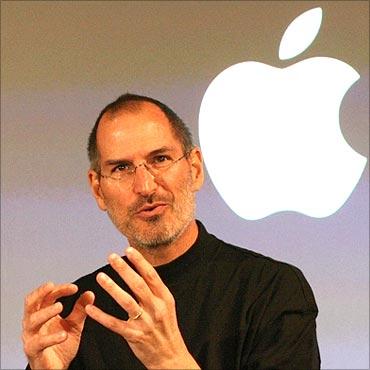

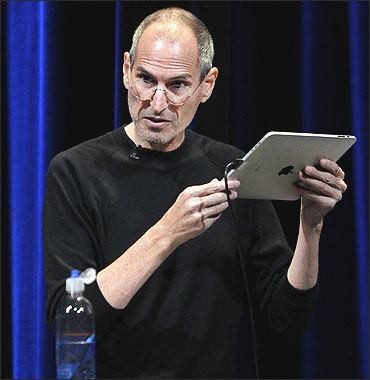
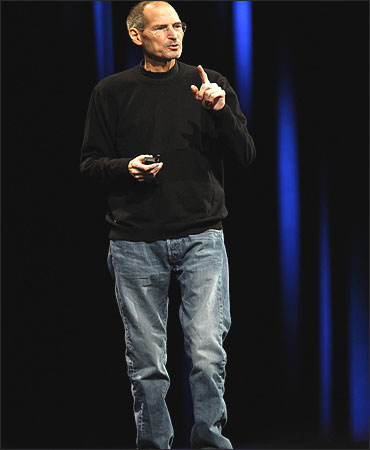
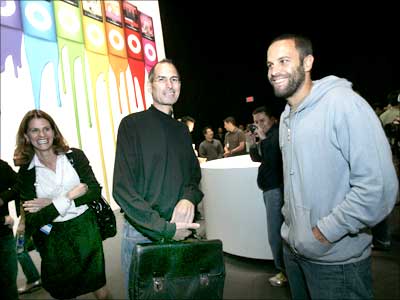
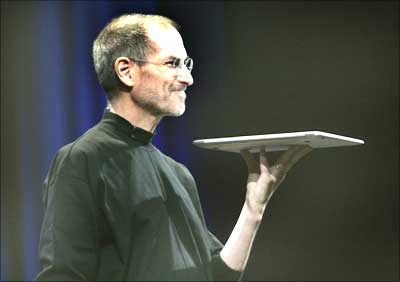
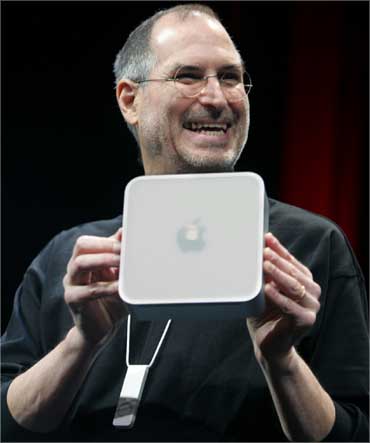


article